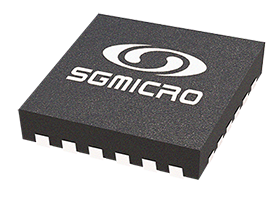

SG Micro’s SGM41509 is a battery charger and system power path management device with integrated converter and power switches for use with single-cell Li-ion or Li-polymer batteries. This highly integrated 5 A device is capable of fast charging and supports 5 V input voltage suitable for smartphones, tablets and portable systems. I2C programming makes it a very flexible powering and charger design solution.
The device includes four main power switches: an input reverse blocking FET, a high-side switching FET for buck or boost mode, a low-side switching FET for buck or boost mode switching, and a battery FET that controls the interconnection of the system and battery. The bootstrap diode for high-side gate driving is also integrated.
The internal power path has a very low impedance that reduces the charging time and maximises battery discharge efficiency. Moreover, input voltage and current regulation provides maximum charging power delivery to the battery with various types of input sources.
The device supports a low-power input voltage (5 V) source and can avoid damage from high-voltage sources with an external N-MOSFET for over-voltage protection. The device also meets the USB On-the-Go (OTG) power rating specification by supplying 5 V (adjustable from 4,5 V to 5,5 V) on the VBUS pin with a default current limit of 2,4 A (adjustable from 1,2 A to 4 A).
The system voltage is regulated slightly above the battery voltage by the power path management circuit and is kept above the programmable minimum system voltage (3,5 V by default). Therefore, system power is maintained even if the battery is completely depleted or removed.
A dynamic power management (DPM) feature is also included that automatically reduces the charge current if the input current or voltage limit is reached. If the system load continues to increase after the reduction of charge current down to zero, the power path management provides the deficit from the battery by discharging it into the system until the system power demand is fulfilled. This is called supplement mode and prevents input source overloading.
Starting and termination of a charging cycle can be accomplished without software control. The sensed battery voltage is used to decide the starting phase for charging from three phases of the charging cycle: pre-conditioning, constant current or constant voltage. When the charge current falls below a preset limit and the battery voltage is above the recharge threshold, the charger function will automatically terminate and end the charging cycle. If the voltage of a charged battery falls below the recharge threshold, the charger starts another charging cycle.
Several safety features are integrated into the SGM41509, such as over-voltage and over-current protection, charging safety timing, thermal shutdown and input under-voltage lockout. This device also features thermal regulation by which the charge current is reduced if the junction temperature exceeds 120℃ (selectable).
Charging status is reported by the STAT output and fault/status bits. A negative pulse is sent to the nINT output pin as soon as a fault occurs to notify the host. BATFET reset control is provided by the nQON pin to exit default mode or for a full system reset.
The device is available in a TQFN-4x4-24L package.
| Tel: | +27 11 781 2029 |
| Email: | [email protected] |
| www: | www.icorptechnologies.co.za |
| Articles: | More information and articles about iCorp Technologies |

© Technews Publishing (Pty) Ltd | All Rights Reserved